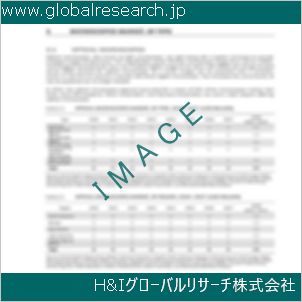1 市場概要
1.1 製品概要と範囲
1.2 市場推定の注意点と基準年
1.3 タイプ別市場分析
1.3.1 概要:グローバルレベル指標 タイプ別消費価値:2020年対2024年対2031年
1.3.2 ダイヤル指標
1.3.3 デジタル指標
1.4 用途別市場分析
1.4.1 概要:グローバルレベル指標 用途別消費額:2020年対2024年対2031年
1.4.2 石油産業
1.4.3 化学産業
1.4.4 製薬産業
1.4.5 その他
1.5 グローバルレベル指標 市場規模と予測
1.5.1 グローバルレベル指標の消費額(2020年、2024年、2031年)
1.5.2 グローバルレベル指標の販売数量(2020年~2031年)
1.5.3 グローバルレベル指標の平均価格(2020年~2031年)
2 メーカープロファイル
2.1 ABB
2.1.1 ABBの詳細
2.1.2 ABBの主要事業
2.1.3 ABB レベル指標 製品とサービス
2.1.4 ABB レベル表示器の売上数量、平均価格、売上高、粗利益率、市場シェア(2020-2025)
2.1.5 ABBの最近の動向/更新
2.2 Endress+Hauser
2.2.1 Endress+Hauserの詳細
2.2.2 Endress+Hauser 主な事業
2.2.3 Endress+Hauser レベルインジケーター製品およびサービス
2.2.4 Endress+Hauser レベルインジケーターの販売数量、平均価格、売上高、粗利益率、市場シェア(2020-2025)
2.2.5 Endress+Hauser の最近の動向/更新
2.3 KROHNE Messtechnik
2.3.1 KROHNE Messtechnikの詳細
2.3.2 KROHNE Messtechnik 主な事業
2.3.3 KROHNE Messtechnik レベル表示器の製品とサービス
2.3.4 KROHNE メステクニク レベルインジケーターの販売数量、平均価格、売上高、粗利益率、市場シェア(2020-2025)
2.3.5 KROHNE メステクニクスの最近の動向/更新
2.4 ELESA
2.4.1 ELESA 詳細
2.4.2 ELESA 主な事業
2.4.3 ELESA レベルインジケーター製品とサービス
2.4.4 ELESA レベル表示器の販売数量、平均価格、売上高、粗利益率、市場シェア(2020-2025)
2.4.5 ELESA の最近の動向/最新情報
2.5 WIKA アレクサンダー・ウィーガンド
2.5.1 WIKA アレクサンダー・ウィーガンドの詳細
2.5.2 WIKA アレクサンダー・ウィーガンドの主な事業
2.5.3 WIKA アレクサンダー・ウィーガンド レベルインジケーター 製品およびサービス
2.5.4 WIKA アレクサンダー・ウィーガンド レベルインジケーターの販売数量、平均価格、収益、粗利益率、市場シェア(2020年~2025年
2.5.5 WIKA アレクサンダー・ヴィーガンドの最近の動向/最新情報
2.6 GEMS SENSORS & CONTROLS
2.6.1 GEMS SENSORS & CONTROLS 詳細
2.6.2 GEMS SENSORS & CONTROLS の主な事業
2.6.3 GEMS SENSORS & CONTROLS レベルインジケーター製品およびサービス
2.6.4 GEMS SENSORS & CONTROLS レベルインジケーターの販売数量、平均価格、収益、粗利益率、市場シェア(2020年~2025年
2.6.5 GEMS センサー & コントロール 最近の動向/更新
3 競争環境:レベルインジケーターのメーカー別
3.1 グローバル レベルインジケーター メーカー別販売数量(2020-2025)
3.2 グローバル レベルインジケーター 売上高(メーカー別)(2020-2025)
3.3 グローバルレベル指標:メーカー別平均価格(2020-2025)
3.4 市場シェア分析(2024年)
3.4.1 メーカー別レベル指標の出荷量(売上高 $MM)と市場シェア(%):2024
3.4.2 2024年のレベルインジケーター上位3メーカーの市場シェア
3.4.3 2024年のレベルインジケーター上位6メーカーの市場シェア
3.5 レベルインジケーター市場:全体的な企業足跡分析
3.5.1 レベルインジケーター市場:地域別足跡
3.5.2 レベル表示器市場:企業製品タイプ別足跡
3.5.3 レベルインジケーター市場:企業製品用途別足跡
3.6 新規参入企業と市場参入障壁
3.7 合併、買収、契約、および提携
4 地域別消費分析
4.1 地域別グローバルレベルインジケーター市場規模
4.1.1 地域別グローバルレベルインジケーター販売数量(2020-2031)
4.1.2 グローバルレベル指標の地域別消費額(2020-2031)
4.1.3 グローバルレベル指標の地域別平均価格(2020-2031)
4.2 北米地域別指標消費額(2020-2031)
4.3 欧州レベル指標 消費額(2020-2031)
4.4 アジア太平洋地域別指標 消費額(2020-2031)
4.5 南米地域別指標 消費額(2020-2031)
4.6 中東・アフリカ地域別指標 消費額(2020-2031)
5 市場セグメント別タイプ
5.1 グローバルレベル指標 タイプ別販売数量(2020-2031)
5.2 グローバルレベル指標 タイプ別消費価値(2020-2031)
5.3 グローバルレベル指標 タイプ別平均価格(2020-2031)
6 市場セグメント別(用途)
6.1 グローバルレベル指標 用途別販売数量(2020-2031)
6.2 グローバルレベル指標 用途別消費額(2020-2031)
6.3 グローバルレベル指標 用途別平均価格(2020-2031)
7 北米
7.1 北米レベル指標 タイプ別販売数量(2020-2031)
7.2 北米地域別指標 用途別販売数量(2020-2031)
7.3 北米地域別指標 国別市場規模
7.3.1 北米レベル指標の国別販売数量(2020-2031)
7.3.2 北米レベルインジケーターの消費額(国別)(2020-2031)
7.3.3 アメリカ市場規模と予測(2020-2031)
7.3.4 カナダ市場規模と予測(2020-2031)
7.3.5 メキシコ市場規模と予測(2020-2031)
8 ヨーロッパ
8.1 ヨーロッパ地域別指標 製品タイプ別販売数量(2020-2031)
8.2 欧州レベル指標 用途別販売数量(2020-2031)
8.3 欧州レベル指標 国別市場規模
8.3.1 欧州レベル指標 国別販売数量(2020-2031)
8.3.2 欧州レベル指標の消費額(国別)(2020-2031)
8.3.3 ドイツ市場規模と予測(2020-2031)
8.3.4 フランス市場規模と予測(2020-2031)
8.3.5 イギリス市場規模と予測(2020-2031)
8.3.6 ロシア市場規模と予測(2020-2031)
8.3.7 イタリア市場規模と予測(2020-2031)
9 アジア太平洋
9.1 アジア太平洋地域レベル指標 製品タイプ別販売数量(2020-2031)
9.2 アジア太平洋地域別指標 用途別販売数量(2020-2031)
9.3 アジア太平洋地域別市場規模(地域別)
9.3.1 アジア太平洋地域別販売数量(2020-2031)
9.3.2 アジア太平洋地域レベル指標の地域別消費額(2020-2031)
9.3.3 中国市場規模と予測(2020-2031)
9.3.4 日本市場規模と予測(2020-2031)
9.3.5 韓国市場規模と予測(2020-2031)
9.3.6 インド市場規模と予測(2020-2031)
9.3.7 東南アジア市場規模と予測(2020-2031)
9.3.8 オーストラリア市場規模と予測(2020-2031)
10 南米
10.1 南米地域別指標 製品タイプ別販売数量(2020-2031)
10.2 南米地域別指標 用途別販売数量(2020-2031)
10.3 南米地域別市場規模(国別)
10.3.1 南米地域別指標 国別販売数量(2020-2031)
10.3.2 南米レベル指標 国別消費額(2020-2031)
10.3.3 ブラジル市場規模と予測(2020-2031)
10.3.4 アルゼンチン市場規模と予測(2020-2031)
11 中東・アフリカ
11.1 中東・アフリカ地域別レベル指標販売数量(2020-2031)
11.2 中東・アフリカ地域 レベル指標 アプリケーション別販売数量(2020-2031)
11.3 中東・アフリカ地域別指標 国別市場規模
11.3.1 中東・アフリカ地域別指標 国別販売数量(2020-2031)
11.3.2 中東・アフリカ地域 レベル指標 消費額(国別)(2020-2031)
11.3.3 トルコ市場規模と予測(2020-2031)
11.3.4 エジプト市場規模と予測(2020-2031)
11.3.5 サウジアラビア市場規模と予測(2020-2031)
11.3.6 南アフリカ市場規模と予測(2020-2031)
12 市場動向
12.1 レベル指標 市場ドライバー
12.2 レベル指標の市場制約
12.3 レベル指標のトレンド分析
12.4 ポーターの5つの力分析
12.4.1 新規参入の脅威
12.4.2 供給者の交渉力
12.4.3 購入者の交渉力
12.4.4 代替品の脅威
12.4.5 競争の激化
13 原材料と産業チェーン
13.1 レベル指標の原材料と主要メーカー
13.2 レベル指標の製造コストの割合
13.3 レベル指標の製造プロセス
13.4 産業バリューチェーン分析
14 流通チャネル別出荷量
14.1 販売チャネル
14.1.1 直接エンドユーザー向け
14.1.2 卸売業者
14.2 レベル指標典型的な卸売業者
14.3 レベル指標(典型的な顧客)
15 研究結果と結論
16 付録
16.1 方法論
16.2 研究プロセスとデータソース
16.3 免責事項
1.1 Product Overview and Scope
1.2 Market Estimation Caveats and Base Year
1.3 Market Analysis by Type
1.3.1 Overview: Global Level Indicators Consumption Value by Type: 2020 Versus 2024 Versus 2031
1.3.2 Dial Indicator
1.3.3 Digital Indicator
1.4 Market Analysis by Application
1.4.1 Overview: Global Level Indicators Consumption Value by Application: 2020 Versus 2024 Versus 2031
1.4.2 Petroleum Industry
1.4.3 Chemical Industry
1.4.4 Pharmaceutical Industry
1.4.5 Others
1.5 Global Level Indicators Market Size & Forecast
1.5.1 Global Level Indicators Consumption Value (2020 & 2024 & 2031)
1.5.2 Global Level Indicators Sales Quantity (2020-2031)
1.5.3 Global Level Indicators Average Price (2020-2031)
2 Manufacturers Profiles
2.1 ABB
2.1.1 ABB Details
2.1.2 ABB Major Business
2.1.3 ABB Level Indicators Product and Services
2.1.4 ABB Level Indicators Sales Quantity, Average Price, Revenue, Gross Margin and Market Share (2020-2025)
2.1.5 ABB Recent Developments/Updates
2.2 Endress+Hauser
2.2.1 Endress+Hauser Details
2.2.2 Endress+Hauser Major Business
2.2.3 Endress+Hauser Level Indicators Product and Services
2.2.4 Endress+Hauser Level Indicators Sales Quantity, Average Price, Revenue, Gross Margin and Market Share (2020-2025)
2.2.5 Endress+Hauser Recent Developments/Updates
2.3 KROHNE Messtechnik
2.3.1 KROHNE Messtechnik Details
2.3.2 KROHNE Messtechnik Major Business
2.3.3 KROHNE Messtechnik Level Indicators Product and Services
2.3.4 KROHNE Messtechnik Level Indicators Sales Quantity, Average Price, Revenue, Gross Margin and Market Share (2020-2025)
2.3.5 KROHNE Messtechnik Recent Developments/Updates
2.4 ELESA
2.4.1 ELESA Details
2.4.2 ELESA Major Business
2.4.3 ELESA Level Indicators Product and Services
2.4.4 ELESA Level Indicators Sales Quantity, Average Price, Revenue, Gross Margin and Market Share (2020-2025)
2.4.5 ELESA Recent Developments/Updates
2.5 WIKA Alexander Wiegand
2.5.1 WIKA Alexander Wiegand Details
2.5.2 WIKA Alexander Wiegand Major Business
2.5.3 WIKA Alexander Wiegand Level Indicators Product and Services
2.5.4 WIKA Alexander Wiegand Level Indicators Sales Quantity, Average Price, Revenue, Gross Margin and Market Share (2020-2025)
2.5.5 WIKA Alexander Wiegand Recent Developments/Updates
2.6 GEMS SENSORS & CONTROLS
2.6.1 GEMS SENSORS & CONTROLS Details
2.6.2 GEMS SENSORS & CONTROLS Major Business
2.6.3 GEMS SENSORS & CONTROLS Level Indicators Product and Services
2.6.4 GEMS SENSORS & CONTROLS Level Indicators Sales Quantity, Average Price, Revenue, Gross Margin and Market Share (2020-2025)
2.6.5 GEMS SENSORS & CONTROLS Recent Developments/Updates
3 Competitive Environment: Level Indicators by Manufacturer
3.1 Global Level Indicators Sales Quantity by Manufacturer (2020-2025)
3.2 Global Level Indicators Revenue by Manufacturer (2020-2025)
3.3 Global Level Indicators Average Price by Manufacturer (2020-2025)
3.4 Market Share Analysis (2024)
3.4.1 Producer Shipments of Level Indicators by Manufacturer Revenue ($MM) and Market Share (%): 2024
3.4.2 Top 3 Level Indicators Manufacturer Market Share in 2024
3.4.3 Top 6 Level Indicators Manufacturer Market Share in 2024
3.5 Level Indicators Market: Overall Company Footprint Analysis
3.5.1 Level Indicators Market: Region Footprint
3.5.2 Level Indicators Market: Company Product Type Footprint
3.5.3 Level Indicators Market: Company Product Application Footprint
3.6 New Market Entrants and Barriers to Market Entry
3.7 Mergers, Acquisition, Agreements, and Collaborations
4 Consumption Analysis by Region
4.1 Global Level Indicators Market Size by Region
4.1.1 Global Level Indicators Sales Quantity by Region (2020-2031)
4.1.2 Global Level Indicators Consumption Value by Region (2020-2031)
4.1.3 Global Level Indicators Average Price by Region (2020-2031)
4.2 North America Level Indicators Consumption Value (2020-2031)
4.3 Europe Level Indicators Consumption Value (2020-2031)
4.4 Asia-Pacific Level Indicators Consumption Value (2020-2031)
4.5 South America Level Indicators Consumption Value (2020-2031)
4.6 Middle East & Africa Level Indicators Consumption Value (2020-2031)
5 Market Segment by Type
5.1 Global Level Indicators Sales Quantity by Type (2020-2031)
5.2 Global Level Indicators Consumption Value by Type (2020-2031)
5.3 Global Level Indicators Average Price by Type (2020-2031)
6 Market Segment by Application
6.1 Global Level Indicators Sales Quantity by Application (2020-2031)
6.2 Global Level Indicators Consumption Value by Application (2020-2031)
6.3 Global Level Indicators Average Price by Application (2020-2031)
7 North America
7.1 North America Level Indicators Sales Quantity by Type (2020-2031)
7.2 North America Level Indicators Sales Quantity by Application (2020-2031)
7.3 North America Level Indicators Market Size by Country
7.3.1 North America Level Indicators Sales Quantity by Country (2020-2031)
7.3.2 North America Level Indicators Consumption Value by Country (2020-2031)
7.3.3 United States Market Size and Forecast (2020-2031)
7.3.4 Canada Market Size and Forecast (2020-2031)
7.3.5 Mexico Market Size and Forecast (2020-2031)
8 Europe
8.1 Europe Level Indicators Sales Quantity by Type (2020-2031)
8.2 Europe Level Indicators Sales Quantity by Application (2020-2031)
8.3 Europe Level Indicators Market Size by Country
8.3.1 Europe Level Indicators Sales Quantity by Country (2020-2031)
8.3.2 Europe Level Indicators Consumption Value by Country (2020-2031)
8.3.3 Germany Market Size and Forecast (2020-2031)
8.3.4 France Market Size and Forecast (2020-2031)
8.3.5 United Kingdom Market Size and Forecast (2020-2031)
8.3.6 Russia Market Size and Forecast (2020-2031)
8.3.7 Italy Market Size and Forecast (2020-2031)
9 Asia-Pacific
9.1 Asia-Pacific Level Indicators Sales Quantity by Type (2020-2031)
9.2 Asia-Pacific Level Indicators Sales Quantity by Application (2020-2031)
9.3 Asia-Pacific Level Indicators Market Size by Region
9.3.1 Asia-Pacific Level Indicators Sales Quantity by Region (2020-2031)
9.3.2 Asia-Pacific Level Indicators Consumption Value by Region (2020-2031)
9.3.3 China Market Size and Forecast (2020-2031)
9.3.4 Japan Market Size and Forecast (2020-2031)
9.3.5 South Korea Market Size and Forecast (2020-2031)
9.3.6 India Market Size and Forecast (2020-2031)
9.3.7 Southeast Asia Market Size and Forecast (2020-2031)
9.3.8 Australia Market Size and Forecast (2020-2031)
10 South America
10.1 South America Level Indicators Sales Quantity by Type (2020-2031)
10.2 South America Level Indicators Sales Quantity by Application (2020-2031)
10.3 South America Level Indicators Market Size by Country
10.3.1 South America Level Indicators Sales Quantity by Country (2020-2031)
10.3.2 South America Level Indicators Consumption Value by Country (2020-2031)
10.3.3 Brazil Market Size and Forecast (2020-2031)
10.3.4 Argentina Market Size and Forecast (2020-2031)
11 Middle East & Africa
11.1 Middle East & Africa Level Indicators Sales Quantity by Type (2020-2031)
11.2 Middle East & Africa Level Indicators Sales Quantity by Application (2020-2031)
11.3 Middle East & Africa Level Indicators Market Size by Country
11.3.1 Middle East & Africa Level Indicators Sales Quantity by Country (2020-2031)
11.3.2 Middle East & Africa Level Indicators Consumption Value by Country (2020-2031)
11.3.3 Turkey Market Size and Forecast (2020-2031)
11.3.4 Egypt Market Size and Forecast (2020-2031)
11.3.5 Saudi Arabia Market Size and Forecast (2020-2031)
11.3.6 South Africa Market Size and Forecast (2020-2031)
12 Market Dynamics
12.1 Level Indicators Market Drivers
12.2 Level Indicators Market Restraints
12.3 Level Indicators Trends Analysis
12.4 Porters Five Forces Analysis
12.4.1 Threat of New Entrants
12.4.2 Bargaining Power of Suppliers
12.4.3 Bargaining Power of Buyers
12.4.4 Threat of Substitutes
12.4.5 Competitive Rivalry
13 Raw Material and Industry Chain
13.1 Raw Material of Level Indicators and Key Manufacturers
13.2 Manufacturing Costs Percentage of Level Indicators
13.3 Level Indicators Production Process
13.4 Industry Value Chain Analysis
14 Shipments by Distribution Channel
14.1 Sales Channel
14.1.1 Direct to End-User
14.1.2 Distributors
14.2 Level Indicators Typical Distributors
14.3 Level Indicators Typical Customers
15 Research Findings and Conclusion
16 Appendix
16.1 Methodology
16.2 Research Process and Data Source
16.3 Disclaimer
| ※参考情報 レベルインジケーターは、液体や固体の物質のレベルを測定・表示するための装置やシステムを指します。これらは、工業分野や家庭、環境モニタリングなどさまざまな用途で幅広く利用されています。レベルインジケーターを使用することで、プロセスの効率や安全性が向上し、無駄なコストを削減することが可能となります。 レベルインジケーターの定義は、その機能に密接に関連しています。それは、内部にある物質のレベルを正確に測定し、その結果を視覚的にわかりやすく表示することです。これにより、操作する人は必要に応じたアクションを迅速に判断し、適切な対応を取ることができます。 レベルインジケーターの特徴として、以下の点が挙げられます。まず、測定精度です。高い精度でレベルを測定することが求められます。次に、耐久性です。特に産業用のインジケーターは厳しい環境下でも機能し続けることが求められるため、材料や構造に厳しい基準が設けられています。また、設置やメンテナンスの容易さも重要な要素であり、操作する人が手間なく使用できることが期待されます。 レベルインジケーターには大きく分けてアナログ式とデジタル式があります。アナログ式は、バルブやゲージに物理的な指針があり、その指針の位置でレベルを示します。一方、デジタル式は電気信号を用いてレベルを測定し、数値やグラフで表示します。最近では、デジタルインジケーターが普及しており、より正確な測定が可能となっています。 レベルインジケーターの主な種類としては、フロート式、圧力式、超音波式、電磁波式、光学式などがあります。フロート式は、浮き上がる構造を持ち、液体の表面に浮かぶフロートがあるレベルを示します。圧力式は、液体が持つ圧力を利用し、その圧力値から液面レベルを算出します。超音波式は、超音波の反射を利用して物質のレベルを測定し、非接触での測定が可能です。電磁波式は、マイクロ波やレーザーを用いて物質の表面までの距離を測り、そこからレベルを計算します。光学式は、物質の透過率や反射率の変化を利用してレベルを測る方法で、特に透明な液体に対して効果的です。 用途については、レベルインジケーターが多岐にわたる業界で使用されています。例えば、化学プラントでは、反応槽や貯蔵タンクのレベルを監視するために用いられます。食品産業では、液体の品質を保つために重要であり、飲料や液体食品の生産過程でも使用されています。また、環境モニタリングでは、河川や湖沼の水位を測定するために利用され、洪水対策や水資源管理に貢献しています。 関連技術としては、IoT(モノのインターネット)やデジタルデータ処理技術の進化があります。これにより、レベルインジケーターから得られたデータをリアルタイムで収集、分析し、フィードバックを提供することが可能です。クラウドコンピューティングと組み合わせることで、遠隔地からのモニタリングやデータの可視化が実現され、作業の効率化が図られています。 さらに、フィールドバス技術や産業用通信プロトコルの導入も進んでおり、さまざまな機器との連携が容易になりました。これにより、工場の自動化が進み、効率的なプロセス管理が実現されています。 レベルインジケーターは、古くから存在する技術でありながら、現代の高度な技術と融合し続けています。これによって、その適用範囲は拡大し、より効率的で安全な方法で物質の管理が行われるようになっています。 最後に、レベルインジケーターの導入にあたっては、必要とされる精度や環境条件、コストを十分に考慮することが重要です。各種インジケーターが市場に出ている中から、適切な機器を選択するためには、専門的な知識や経験が求められることもあります。 このように、レベルインジケーターは、物質の管理を行う上で不可欠なツールであり、その技術と利用法は今後も進化していくことでしょう。設置場所や用途に応じて最適な選択をし、効果的に活用することが求められます。 |
❖ 免責事項 ❖
http://www.globalresearch.jp/disclaimer












